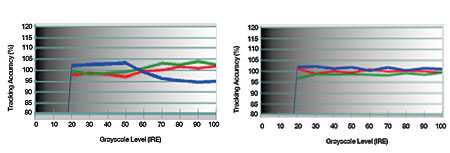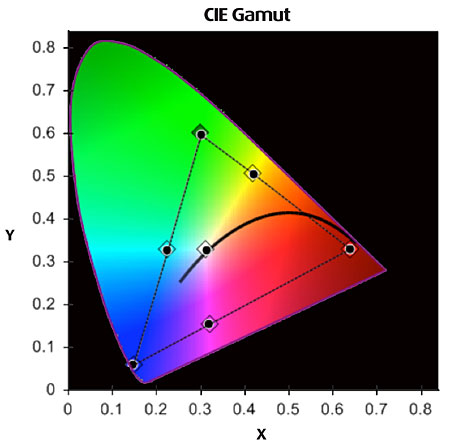Runco Q-750i LED DLP Projector HT Labs Measures
Black: 0.002
White: 14.85
Full-On/Full-Off Contrast Ratio: 7,425:1
Unless indicated otherwise, all of the measurements here were taken in User 1 picture setting mode with ConstantContrast engaged through an HDMI input, with the set adjusted for the most accurate picture in a darkened room. Note that the screen was a 92-inch-wide Stewart Filmscreen StudioTek 130 G3, which is substantially larger than the 78-inch-wide StudioTek 130 that Tom Norton uses for his projector measurements. For an apples-to-apples comparison, multiply the above black and white numbers by 1.39 to get the approximate readings likely on the 78-inch-wide screen (not measured here). The full-on/full-off contrast ratio should be the same on both screens. 1.39 is the ratio of the areas of the two screens, and this number assumes that the two have exactly the same gain. Both are StudioTek 130s, and their specified gains are both 1.3. But mine is a G3, and Tom’s is not; it dates back to 2001, well before the G3 was introduced, so there may be small differences.

The Q-750i’s contrast ratio was measured with the projector set up conservatively—the black pedestal was set correctly, and it was showing the entire range above white and putting out a very punchy 14.85 footlamberts with the Contrast set at just 62. Turning ConstantContrast off dropped the contrast ratio to 1,620:1. It’s been speculated that because of the on/off nature of LEDs, total blackouts during scene transitions are possible using dynamic contrast features such as ConstantContrast. This was not the case with the Q-750i, at least with the black level set anywhere near correctly and ConstantContrast set to Low to avoid artifacts with program material. This is terrific performance, so that’s an observation, not a criticism. Speaking of which, I followed Runco’s recommendation and turned ConstantContrast off to adjust the black and white levels and perform my gray-scale measurements and calibration. With ConstantContrast off, the most technically correct black level (Brightness) is 103, but I got a bit better contrast adjusting to 102 with ConstantContrast on. The minor amount of shadow detail I might have sacrificed was a small price to pay for the subjective improvement in contrast.

Although truly exceptional after calibration, the gray-scale tracking was excellent out of the box when set to 6500k. As with the Runco LS-5 out of the box, the Rec. 709 color gamut was nearly perfect. I essentially made the already great color tracking perfect with the gray scale and PCE adjustments just because I could; the picture looked great. Gray-scale tracking and color were so tight with respect to Delta E numbers that there was essentially no visible deviation. Delta E numbers of 3 or less are regarded as invisible to the eye; between gray scale and color, including luminance, the Q-750i had no single measured metric with a Delta E higher than 2. It looked as sensational as it measured with program material.

The 2.2 and 2.35 gamma curves measured spot on. Resolution with 1080p input signals extended to the highest luma and chroma frequencies, uniformity and everything else I looked at was beyond reproach. This is excellent measured performance. —SCB
























































